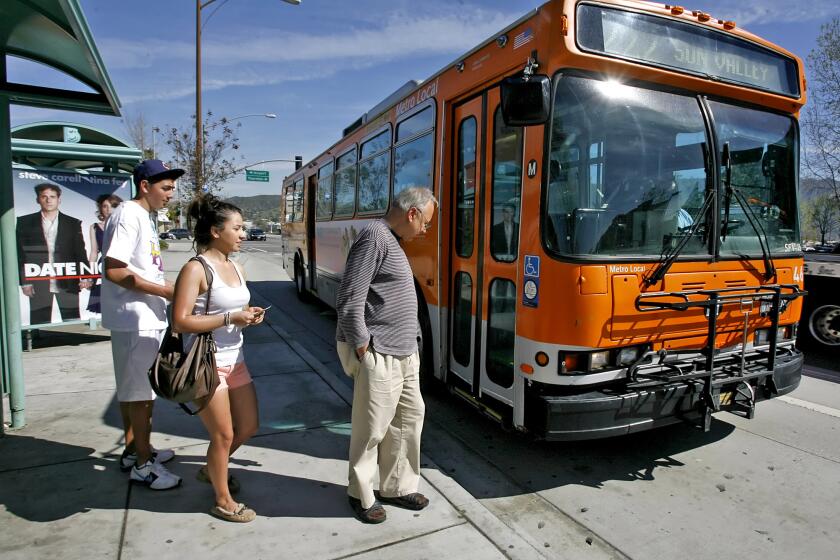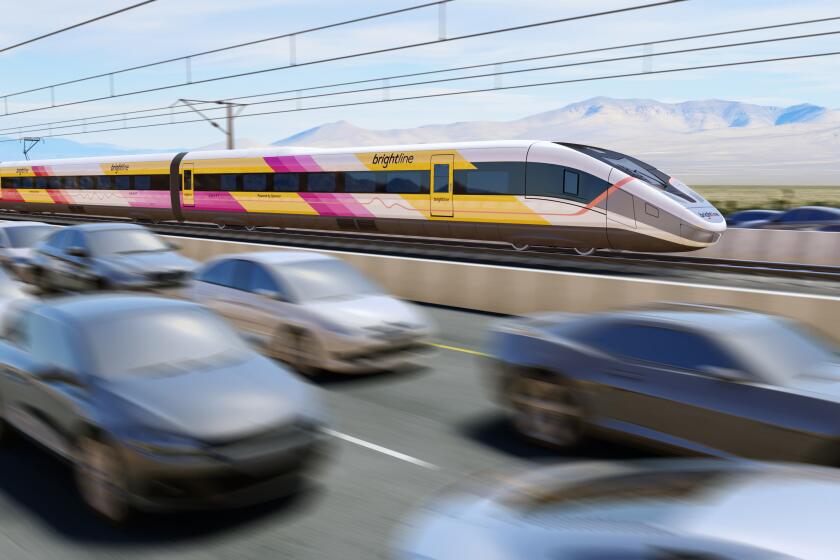Digging of Twin Tunnels Under Valley Complete
Delighted to have a distraction from mining mishaps in the Santa Monica Mountains, the Metropolitan Transportation Authority announced on Wednesday that it had completed digging twin tunnels that will one day connect subway stations in North Hollywood and Universal City.
The transit agency expressed pride that its contractor’s employees lost no work days to accidents as they excavated the 2-mile-long tunnels over the past two years, and that the tunnels had passed beneath the cement bed of the Los Angeles River without displacing a drop of water.
But officials’ satisfaction may be dimmed when they examine the final invoice for the job, which a Japan-based construction giant, the Obayashi Corp., originally promised to do for $64 million.
So far the project is at least $20 million over budget and 367 days late, according to records kept by the federal government, which is paying for half the project.
And Obayashi has filed an additional $42.3 million in claims against the MTA to pay for the impact of delays that it claims were caused by the transit agency’s engineering--a figure the agency disputes.
Is that all?
Not likely. Obayashi is barely half finished with the project, according to the federal records. Now that its digging days are done, the contractor must next dig 11 passages between the tunnels by hand, hang plastic sheets against all the walls to keep water out, then finish the job by installing a second foot-wide ring of cement over the length of the tunnels.
Of course, there are also the lawsuits.
At least 100 owners of property and businesses along Lankershim Boulevard have sued the MTA over damage they believed was caused by subway construction. Many more say they plan to sue soon. The ultimate liability the agency faces in court is unknown.
The principal accusations, which the MTA denies: Injecting a cement-like substance into the ground ahead of tunneling machines to harden the area’s sandy soil caused an unreasonable amount of ruckus and mess. And tunneling caused the ground on either side of the tunnels beneath Lankershim Boulevard to sink.
Isabel Lopez, for one, arrived for work one rainy March night at her El Sombrero nightclub to discover that her floor had sunk 9 inches. By the next day, the floor had dropped another 6 inches.
She blamed tunneling. The MTA first blamed leftover damage from the 1994 Northridge earthquake, then said that a broken water spout outside her neighbor’s building had caused a flood of water to wash away the dirt below her floor.
Three weeks later, fledgling MTA chief executive Joseph E. Drew attempted to put a friendlier spin on Lopez’s predicament--calling a news conference outside her red-tagged nightclub to announce that the agency would send in contractors to fix the place up and have her back in business in less than a month. Though he continued to deny that tunneling had caused the damage, Drew promised to pay Lopez’s mortgage and other expenses until merrymakers returned to her dance floor.
Four months later, Lopez says that not a lick of repair has been done. She says the MTA stopped sending checks in May when the bill hit $21,000. Her mortgage holder is threatening to foreclose. A lawsuit is pending.
The misery was widely shared.
Across the street, a car stereo dealer has a crack the width of his thumb running across his concrete floor. An auto repair shop has an even fatter crack zigzagging up one wall. Down a few blocks, a furniture retailer claims that the mess of tunneling caused so many customers to stay away that his business plunged 60%. A car dealership whose lot was blocked by two huge vats of chemical grout shut its doors in April. So did a restaurant next to Lopez, whose patrons complained that the soup looked unappetizing when the white dust of tunnel grout settled on it.
MTA project manager Charles Stark said he was sorry about the mess.
“We earnestly apologize for the inconvenience that grouting inflicted on people,” he said in an interview on Wednesday. “It was a difficult operation and we tried to do it as fast as possible.”
Stark noted that the grout--which was used in vast quantities and accounted for the lion’s share of the project’s cost overrun--was required to keep “adverse settlement” of the ground above the tunnel to a minimum.
Considering the troubles the agency encountered, perhaps it was no wonder that Drew thanked the wrong contractor when announcing the conclusion of tunneling to his board of directors Wednesday.
He said he thought Traylor Bros. had done a fine job under Lankershim, before being quickly corrected by a staffer. (Traylor is building the subway tunnel under the Santa Monica Mountains, where work has come to a halt because ground pushing in on the tunnel has trapped a 300-foot-long digging machine nicknamed Thelma.)
It will be another five years before the Red Line subway is scheduled to go into service between the San Fernando Valley and downtown.
Stark said Obayashi is scheduled to finish its work in a year, and tracks will be laid about 18 months after that. At the same time, other contractors are erecting stations in North Hollywood at Lankershim and Chandler boulevards, as well as in Studio City across from Universal Studios. The work is expected to be complete by 2001.
Meanwhile, more bad news may be brewing: For the past three days, sources say, two investigators from the U.S. Senate’s permanent subcommittee on investigations--which has announced a probe of the project--have been interviewing subway critics, local government officials, MTA gadflies, state workers’ safety officials and construction industry whistle-blowers.
The sources say the investigators were most interested in accusations of fraud and corruption related to subway construction. On Wednesday they reportedly were given a six-hour tour of subway construction by MTA officials.
More to Read
Start your day right
Sign up for Essential California for news, features and recommendations from the L.A. Times and beyond in your inbox six days a week.
You may occasionally receive promotional content from the Los Angeles Times.






